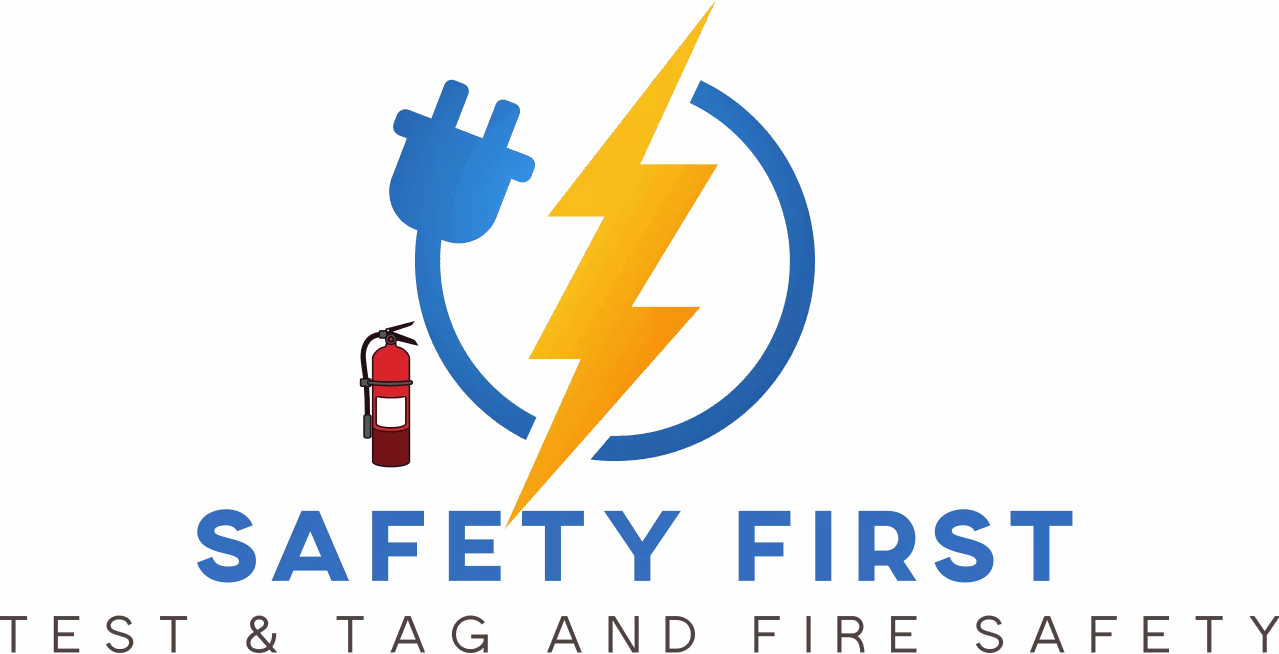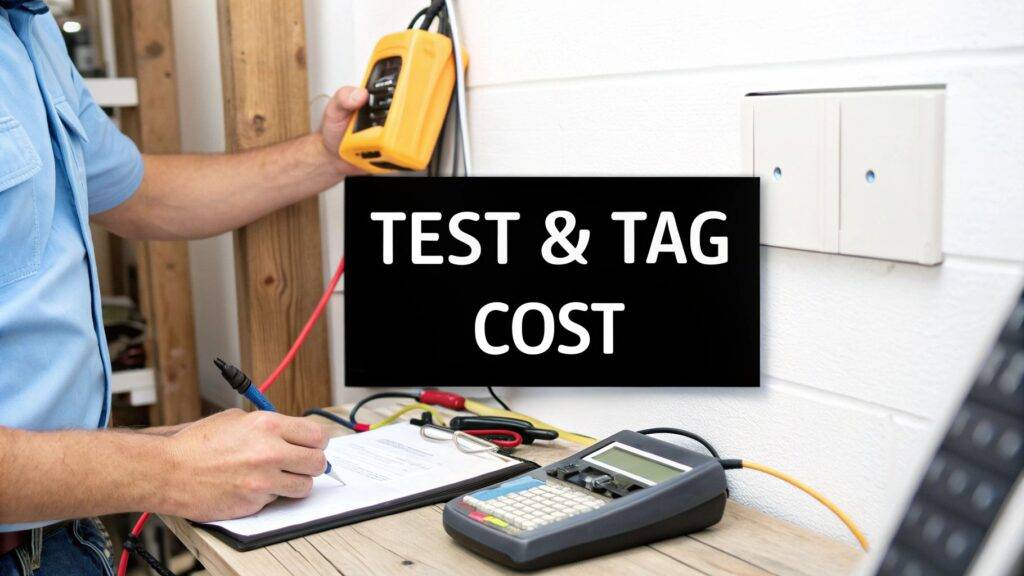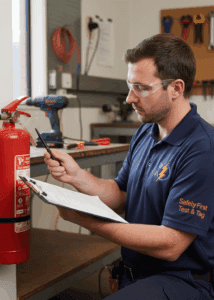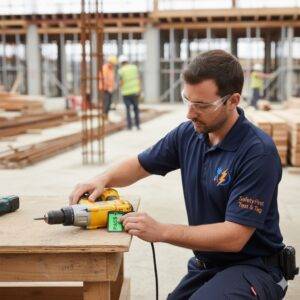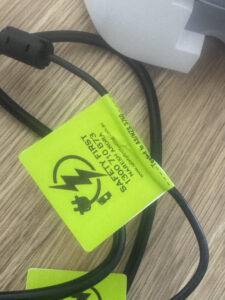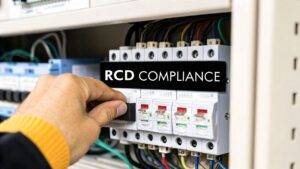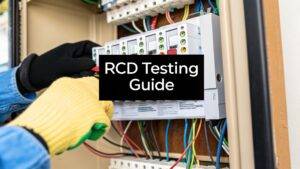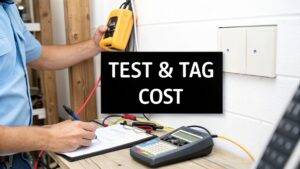So, what’s the bottom line? Whenconsidering he Test and Tag Coast for your business, you’re not looking at a one-size-fits-all price. It’s almost always calculated on a per-item basis, with prices usually landing somewhere between $3.00 to over $9.50 per tag.
On top of that, you’ll generally find a minimum call-out fee. It’s just like getting a sparky or a plumber out to your site—this fee covers their travel time, vehicle costs, and the initial setup required to get the job done right.
Breaking Down Your Test and Tag Quote
When you get a quote, it’s never just one number. Think of it like a mechanic’s invoice—you see a charge for the parts and another for the labour. Test and tag pricing works in a similar way, ensuring it’s fair for everyone, from a small café with a dozen appliances to a massive factory with thousands.
The two main parts of any quote you’ll see are:
- Per-Item Price: This is the heart of the cost. It’s the fee for every single appliance that gets visually inspected, electrically tested, and tagged. The good news? The more items you have, the cheaper this rate usually gets.
- Call-Out Fee: This is a base charge that covers the technician’s overheads—things like fuel, insurance, and the time it takes to set up their specialised testing equipment on-site. It makes it viable for them to handle even smaller jobs efficiently.
For instance, 2025 pricing breakdowns from Adelaide show per-item costs swinging from $3.00 up to $9.50. Minimum service fees in the same area fall between $100 and $250. That big range really shows how much the final bill depends on the number of items you have and the provider’s specific pricing model.
To give you a clearer picture and help with budgeting, let’s lay out what a typical quote might look like.
Typical Test and Tag Cost at a Glance
This table breaks down the common pricing models you’ll encounter for test and tag services across Australia. It gives you a solid idea of what to expect based on the structure your provider uses.
| Pricing Component | Typical Cost Range (ex. GST) | Best For |
|---|---|---|
| Per-Item Fee | $3.50 – $7.00 per tag | Businesses with a moderate to high volume of appliances. |
| Minimum Call-Out Fee | $120 – $200 | Smaller jobs or businesses with only a few items to test. |
| Hourly Rate | $90 – $150 per hour | Situations where the number of items is unknown or the environment is complex. |
Ultimately, understanding these components helps you see exactly what you’re paying for and ensures there are no surprises when the final invoice arrives.
How Providers Calculate Your Final Bill
Trying to figure out your final test and tag bill can feel a bit tricky, mostly because not all quotes are created equal. It’s a bit like picking a mobile phone plan. Some are a simple ‘pay-as-you-go’ deal, which is great if you don’t use much data. Others are a fixed monthly bundle, which makes more sense for a heavy user. Test and tag providers often work in a similar way.
You’ll generally come across four common pricing structures. Each has its own benefits and drawbacks, so understanding them is key to making sure you choose the right fit for your business and avoid any nasty surprises on the invoice.
This infographic gives you a quick rundown of the main things a provider considers when putting together a quote for your business.
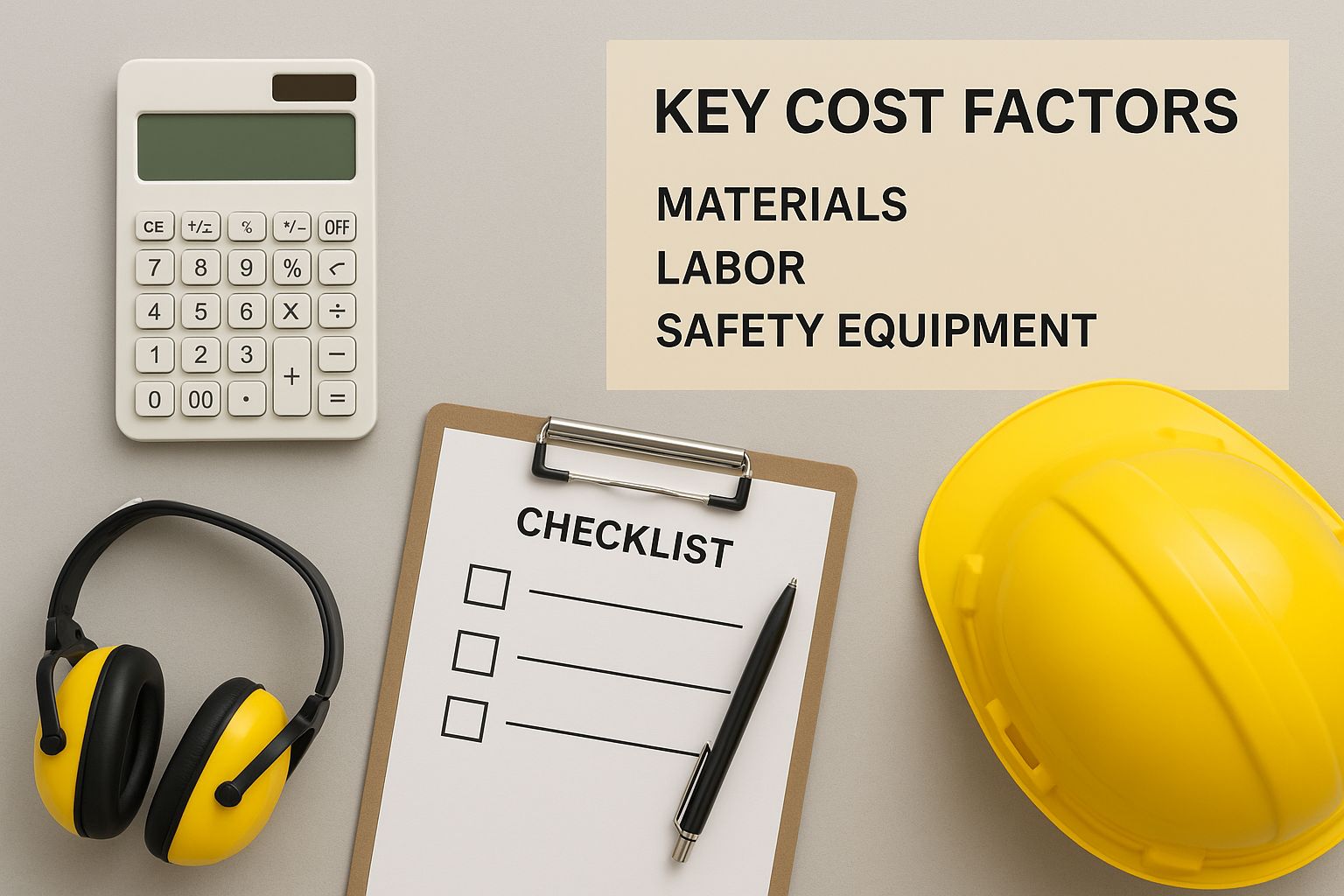
As you can see, the final quote is really a mix of the pricing model, the type of workplace, and the specific equipment you need checked.
Per-Tag Pricing
This is by far the most common model you’ll see. It’s simple: you pay a set price for every single appliance that gets tested and tagged.
- The upside: It’s incredibly transparent and easy to budget for, particularly if you have a good idea of how many items need doing. You’ll often find volume discounts with this model, meaning your cost per tag can drop significantly the more appliances you have.
- The downside: If you’re a small business with just a handful of items, you might not hit the provider’s minimum call-out fee. This means you could end up paying more than the simple per-tag rate would suggest.
Hourly and Flat-Rate Models
Some providers will steer clear of per-item billing, especially for jobs that are more complex or where the number of items isn’t clear-cut.
With an hourly rate, you’re paying for the technician’s time on-site, no matter how many items they get through. This can work out well if you’re organised and all your appliances are easy to get to, as it allows the technician to work super efficiently.
A flat-rate or ‘per site’ fee is just one single price to get the entire job done. This is usually reserved for large, ongoing contracts where the scope of work is really well understood, giving both you and the provider total certainty over the cost.
Across Australia, the way test and tag services are priced really shows the different approaches contractors take. While the per-tag rate is definitely king, other methods like hourly, combination, and fixed rates all have their place. For instance, an hourly rate might look tempting for a business with only a few appliances, but it comes with the risk of a bigger bill if the job takes longer than expected.
Combination Pricing
A combination model does what it says on the tin—it blends elements from the other structures. A provider might offer a lower hourly rate but also charge a reduced per-tag fee on top.
This hybrid approach tries to find a fair balance between paying for the technician’s time and the actual work they complete. It can be a great middle-ground for many medium-sized businesses. Getting your head around the full scope of electrical testing and tagging is the best way to figure out which pricing structure will deliver the best value for your compliance needs.
Got a quote for test and tag services and felt a bit of sticker shock? You’re not alone. It’s easy to assume that if a business down the road with a similar number of appliances paid one price, you should pay the same. But the reality is a little more complicated.
The final test and tag cost isn’t just about a simple item count. A handful of “hidden” factors can dramatically change the time and effort needed for the job, and that’s what really shapes your quote.
Let’s pull back the curtain on what really drives the numbers.
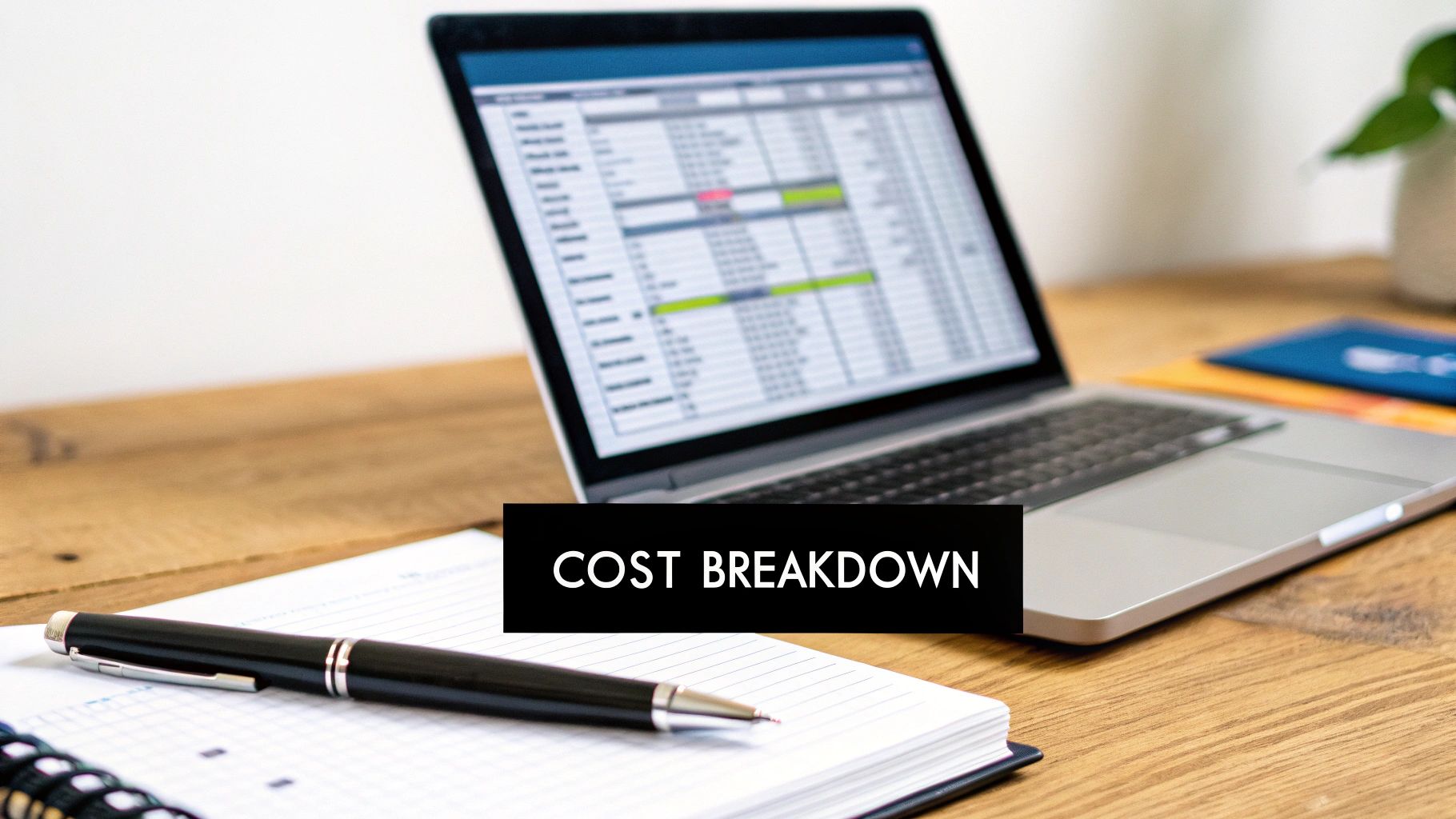
Your Workplace Environment
The single biggest influence on cost? Your worksite. A quiet, tidy office is a world away from a dusty construction site or the controlled chaos of a commercial kitchen. However Each environment has its own unique hurdles that directly impact how quickly and safely a technician can get the work done.
Think about these different scenarios:
- Clean vs. Hostile Environments: Testing equipment in a climate-controlled office is a breeze. But pop that same technician onto a muddy, hazard-filled construction site, and everything slows down.
- Noise and Distractions: Trying to concentrate on precise readings in a loud factory is tough. In a busy cafe, the technician has to constantly work around staff and customers, which naturally adds to the clock.
- Specialised Requirements: Places like hospitals or food processing plants have non-negotiable hygiene rules. Technicians might need to gown up in specific PPE or follow strict sanitisation steps between rooms, adding precious time to every single test.
Appliance Accessibility and Type
Not all appliances are made equal, and their location is just as important. The easier it is for a technician to get their hands on an item, the smoother the job goes—and the more affordable it will be.
Think of it this way: a technician’s time is the core component of the cost. If they spend half their visit moving heavy furniture or tracing cables under desks, that’s time they aren’t spending testing. This “hidden” labour directly inflates the final bill.
Appliance Accessibility:
A computer sitting on a desk? Simple. But what about the server crammed into a tight cabinet, the projector mounted 12 feet up on the ceiling, or the dishwasher plumbed in under a bench? Each one requires extra time and effort to safely access, test, and put back. Just making sure appliances are easy to get to before the technician arrives is one of the easiest ways to keep costs in check.
Appliance Complexity:
The type of equipment itself is a big piece of the puzzle.
- Standard Appliances: Your basic kettle, fan, or laptop? These are quick and take just a minute or two each.
- 3-Phase Machinery: That heavy-duty gear you see in workshops and factories requires a whole different level of expertise and testing. These tests are far more complex and take much longer to complete properly.
- Fixed Equipment: Things that are hard-wired into the wall, like an oven or an air conditioner, often need a licensed electrician to disconnect and reconnect them. That’s a separate skill set and an additional cost to factor in.
Once you start seeing these hidden drivers, you can get a much better handle on what your final test and tag cost will likely be. More importantly, you can take simple steps to make the whole process more efficient, which is good for your schedule and your budget.
How Modern Tech Is Shaping What You Pay
The test and tag industry isn’t stuck in the past. Like everything else, it’s evolving, and these changes directly influence the price you see on your invoice. There’s a bit of a push-and-pull happening right now, driven by a couple of key factors that are worth understanding.
For starters, think about how many more electrical gadgets we all use. The market is flooded with cheaper, often imported appliances. While that’s great for our budgets upfront, it means there are more devices in our workplaces that need checking, increasing the overall demand for diligent testing and compliance. Naturally, higher demand can nudge prices upward.
Smarter Tools Mean Faster Service
But here’s the good news: a powerful counter-force is at play. Technology. The advancements in Portable Appliance Testers (PATs) have been a massive game-changer, making the entire process faster, more accurate, and far more efficient for technicians. This efficiency trickles down to you as the business owner.
What used to involve lugging around bulky equipment and manually scribbling notes is now handled by sleek, handheld devices. These modern testers do more than just check for electrical faults; they streamline the whole administrative side of the job.
- No More Manual Data Entry: Modern PATs automatically log every asset number and test result, virtually eliminating human error and saving a huge amount of time on-site.
- Instant Tag Printing: Forget hard-to-read, handwritten tags. Technicians can now print clear, durable, and professional-looking tags right from their device as soon as an item passes.
- Digital Reports on the Spot: All that data is synced instantly to create detailed digital reports and asset registers. You can often have the complete compliance report in your inbox before the technician has even packed up their van.
This isn’t just about convenience. It’s a direct cost-saver. When a technician can test more items per hour, their own costs go down, allowing them to pass those savings on to you with more competitive per-item pricing.
More Competition Keeps Prices in Check
Perhaps the biggest shift has been how much more accessible the equipment has become. A decade ago, a high-end PAT could easily set you back $5,000+. Today, thanks to incredible leaps in technology, a new technician can get a professional, feature-packed tester for under $1,000. If you’re curious about this shift, Test and Tag Training offers some great insights into how the industry has changed.
This has dramatically lowered the barrier for qualified electricians to start their own test and tag businesses. The result? A much more competitive market. And as any business owner knows, more competition is fantastic for the customer, helping to keep prices fair and service quality high. So when you hire a modern service, you’re not just paying for a sticker on a cord; you’re getting faster, data-driven compliance that simply wasn’t possible a few years ago.
Practical Ways to Lower Your Test and Tag Costs
Keeping your workplace safe and compliant is a must, but it doesn’t have to blow a hole in your budget. With a bit of smart planning, you can bring those test and tag costs down considerably without cutting any corners on safety. Think of it less as an expense and more as a well-managed investment.
The real secret? It all comes down to the technician’s time. The exact same logic applies here. Every minute you can shave off the technician’s time on-site translates directly into savings for your business.
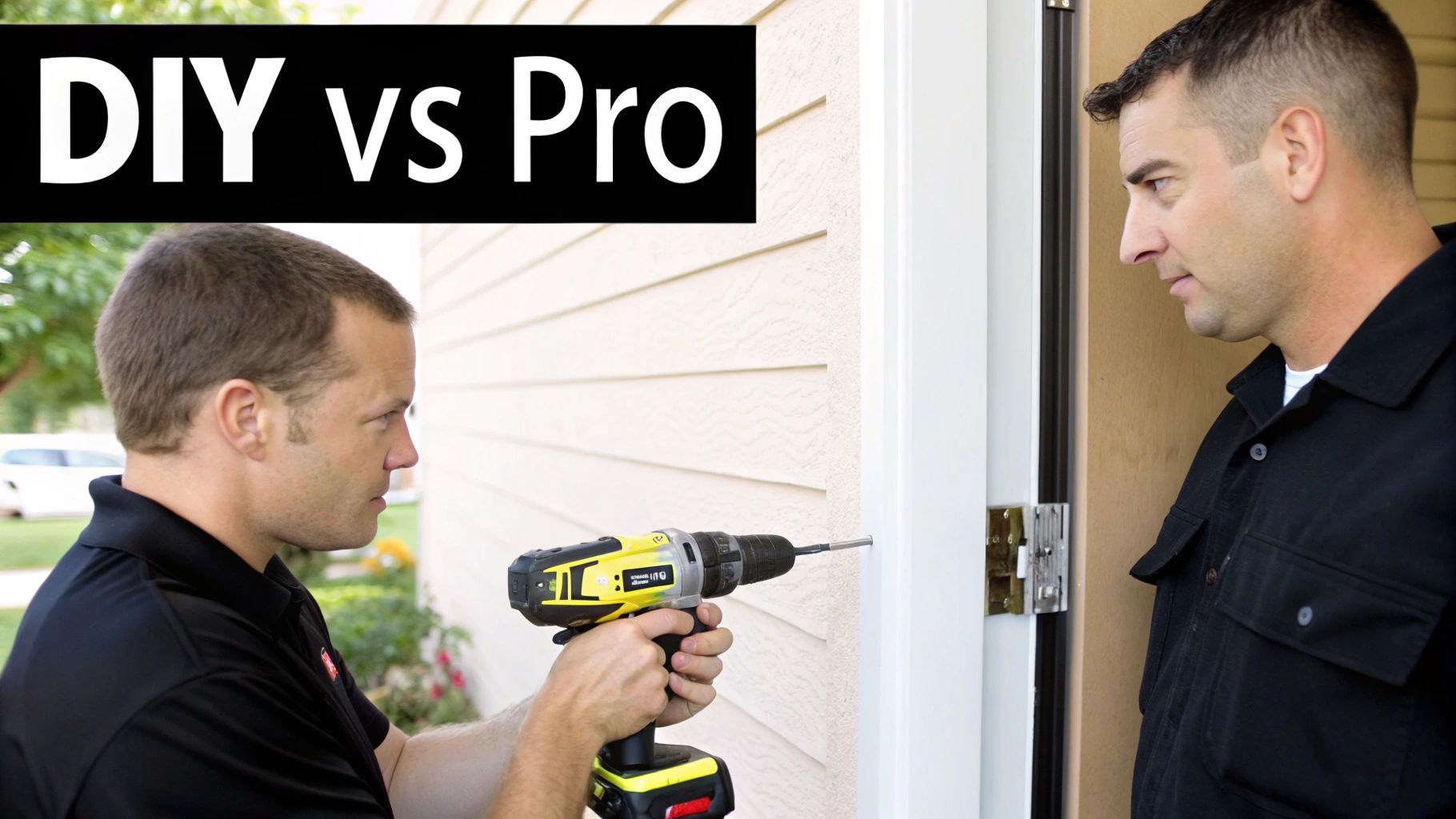
Prepare Your Site Before They Arrive
One of the easiest and most effective ways to save money is to simply get organised before the technician shows up. Make sure every appliance that needs testing is ready and accessible. That means untangling cords, pulling equipment out from under desks, and clearing away any clutter that might be in the way.
This simple prep work can slash the labour time you’re paying for. A technician who can walk in and move methodically from one item to the next is going to finish far quicker than one who has to play hide-and-seek with power boards or shift furniture around just to get started.
Leverage Volume and Bundling
Economies of scale are your best friend when it comes to reducing your per-item cost. The more items you get tested in a single visit, the lower your price per tag is likely to be. It’s just more efficient for a company to test 200 items in one building than it is to test 20 items across ten different sites.
Here’s how to make it work for you:
- Go for a single, annual service: Instead of spreading the testing out, get as much done as you can in one hit. This will push you into a higher volume bracket and unlock better pricing.
- Bundle your safety services: Many test and tag providers also handle other jobs, like testing fire extinguishers or smoke alarms. Asking them to do everything at once will almost always get you a better deal than hiring two or three separate companies.
Lock in Long-Term Savings
Don’t think of testing and tagging as a one-and-done job. When you build a long-term relationship with a provider, you can often negotiate a better rate. Committing to an ongoing service schedule gives them guaranteed work, and they’re usually happy to pass on some savings as a thank you for that loyalty.
A proactive approach doesn’t just save you money; it ensures you never miss a critical compliance deadline. With a service agreement, the provider takes on the responsibility of tracking your re-test dates, which is one less thing for you to worry about.
Many companies even offer a free reminder service to make managing your compliance schedule a breeze. You might want to see how a retest reminder service can help you stay organised and avoid those costly last-minute call-out fees. A little bit of forward-thinking can make workplace safety both affordable and effortless.
How to Get an Accurate Quote and Avoid Surprises
Getting a precise cost for test and tag services really boils down to giving your potential provider the right information from the get-go. Think of it like getting a quote to paint your house; you wouldn’t just ask “how much to paint a house?” You’d give them the number of rooms, the size, and the condition of the walls. The same logic applies here.
Vague requests will always lead to vague, ballpark estimates. When you arm a provider with specific deta. They can give you a firm price, which means the quote you see is the price you’ll actually pay. This also makes it much easier to compare different quotes fairly.
What Information to Have Ready
To get a quote that truly reflects your needs, you’ll want to have a few key details about your workplace on hand. This small bit of prep work eliminates the guesswork for the technician and helps you avoid any unexpected charges down the track.
Before you call or fill out a form, try to pull together a quick summary of:
- Appliance Count: A rough idea of how many items need testing is a great start. Even an estimate like “around 150 items” is far more helpful than nothing at all.
- Appliance Types: Are we talking standard office computers and printers, commercial kitchen gear, or heavy-duty 3-phase machinery? The type of equipment directly influences the time and complexity of the job.
- Work Environment: Give a brief description of your site. Is it a standard office, a busy retail space, a dusty construction workshop, or a sterile medical clinic?
The Questions You Must Ask
Just as important as the information you provide is the information you get back. Asking a few sharp questions can help you spot any red flags and choose a provider who is transparent and professional.
Before you agree to anything, you need to clarify the fine print. A cheap per-tag price can look attractive, but it’s often a smokescreen for a hefty call-out fee or other hidden costs that suddenly appear on the final invoice.
Make a point to ask any potential provider these questions:
- Are you fully insured with both Public Liability and Professional Indemnity insurance?
- Can you confirm your technicians are certified and have completed the proper training?
- What exactly does your call-out fee include? Does it cover travel and the first hour on-site?
Taking these simple steps ensures you can compare quotes with confidence and find a partner who delivers real value, not just a low sticker price. When you’re ready, you can easily get a free, no-obligation quote online to start the process with total clarity.
Common Questions About Test and Tag Costs
When you’re trying to figure out the final bill for electrical compliance, a few common questions always seem to pop up. Let’s tackle some of the queries we hear most from business owners, so you can budget for your test and tag costs with a bit more clarity.
Do I Have to Pay a Call-Out Fee?
In almost every case, yes. A call-out fee is standard practice in the trade, and for good reason. It covers the essential costs of getting a qualified technician to your door, including their travel time, fuel, vehicle upkeep, and the time it takes to set up their specialised testing gear on your site.
Think of it as the base cost that makes it possible for a professional to come out, whether they’re testing ten items or a hundred.
Is Testing and Tagging Cheaper for an Office?
Generally speaking, it is. The environment where the work happens plays a huge role in the overall cost. Additionally office is typically a clean, predictable space where technicians can move around easily and get the job done efficiently.
Compare that to a construction site or a busy workshop, which is full of potential hazards and obstacles. Navigating those challenges slows things down, which naturally pushes the per-item cost up.
Remember, the faster a technician can safely access and test each appliance, the more cost-effective the service becomes. Simpler environments directly translate to lower overall costs for your business.
Can I Get a Discount for More Items?
Absolutely. This is probably the best way to bring your test and tag cost down. Service providers nearly always offer volume discounts. It’s just more efficient for them to test 300 items at one location than it is to test 30 items spread across ten different sites.
If you have a larger number of appliances, always ask about a lower per-item rate. You can often find extra savings by bundling other services, like fire safety checks, into the same visit.
At Safety First Test and Tag and Fire Safety, we believe in clear, upfront pricing to keep your Geelong or Melbourne workplace compliant and safe. Get a free, no-obligation quote to simplify your safety responsibilities today. Learn more at https://safetyfirsttesttag.com.au.
Article created using Outrank
